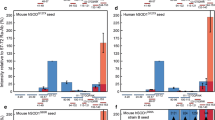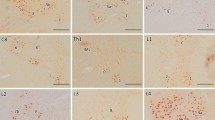Abstract
The ultrastructural features of SOD1-positive aggregates were determined to clarify whether these aggregates are associated with the pathogenesis of SOD1 mutant mice. We examined the spinal cord of transgenic mice expressing a G93A mutant human SOD1 gene with fewer copies (gene copy 10). At the early presymptomatic stage (age 24 weeks), SOD1- and ubiquitin-positive granular, linear, or round deposits were found occasionally in the neuropil of the anterior horns. Ultrastructurally, small filamentous aggregates were observed occasionally in the neuronal processes including the axons in the anterior horns. At the late presymptomatic stage (28 weeks), SOD1- and ubiquitin-positive deposits and Lewy body-like inclusions (LIs) were frequently demonstrated in the neuronal processes including cord-like swollen axons and in some remaining anterior horn neurons. Ultrastructurally, larger filamentous aggregates were frequent, predominating in the neuronal processes of the anterior horns including the proximal axons, but were rare in the somata and dendrites. The aggregates usually consisted of interwoven intermediate filaments (about 10–15 nm in diameter) and frequently contained electron-dense cores in the center resembling LIs. Occasionally the aggregates consisted mainly of granular, amorphous, or vesicular substance, showing fewer filamentous structures. At the symptomatic stages (32 and 35 weeks), LIs were frequently demonstrated within the neuronal processes in the anterior horns, particularly in the cord-like swollen axons. Many more prominent SOD1- and ubiquitin-positive deposits were observed over the whole white matter columns and in the gray matter of the anterior and posterior horns than at the previous stage. Ultrastructurally, aggregates frequently contained electron-dense cores, and were frequently observed in cord-like swollen axons consisting of accumulated neurofilaments. A high level of human SOD1-and ubiquitin-immunogold labeling was present in small to large aggregates even at the presymptomatic stages, and the aggregates increased in size and frequency with time. Compactly packed filaments and electron-dense cores of aggregates showed SOD1-and ubiquitin-immunogold labeling more prominently than in loosely packed filaments. These findings suggest that the accumulation of SOD1-positive aggregates in the neuronal processes, predominantly in the axons, constitutes an important determinant of neurotoxicity and the pathogenesis of this animal model, probably causing impairment of axonal transport by the sequestration of mutant SOD1 protein within aggregates, or in part by physically blocking the axonal transport.














Similar content being viewed by others
References
Beaulieu JM, Jacomy H, Julien J-P (2000) Formation of intermediate filament protein aggregates with disparate effects in two transgenic mouse models lacking the neurofilament light subunit. J Neurosci 20:5321–5328
Bruijin LI, Houseweart MK, Kato S, Anderson KL, Anderson SD, Ohama E, Reaume AG, Scott RW, Cleveland DW (1998) Aggregation and motor neuron toxicity of an ALS-linked SOD1 mutant independent from wild-type SOD1. Science 281:1851–1854
Clement AM, Nguyen MD, Roberts EA, et al (2003) Wild-type nonneuronal cells extend survival of SOD1 mutant motor neurons in ALS mice. Science 302:113–117
Cleveland DW, Jian L (2000) Oxidation versus aggregation—how do SOD1 mutants cause ALS? Nat Med 6:1320–1321
Dal Canto MC, Gurney ME (1994) Development of central nervous system pathology in a murine transgenic model of human amyotrophic lateral sclerosis. Am J Pathol 145:1271–1280
Dal Canto MC, Gurney ME (1997) A low expressor line of transgenic mice carrying a mutant human Cu, Zn superoxide dismutase (SOD1) gene develops pathological changes that most closely resemble those in human amyotrophic lateral sclerosis. Acta Neuropathol 93:537–550
Gurney ME, Pu H, Chiu AY, et al (1994) Motor neuron degeneration in mice that express a human Cu/Zn superoxide dismutase mutation. Science 264:1772–1775
Johnston JA, Dalton MJ, Gurney ME, Kopito RR (2000) Formation of high molecular weight complexes of mutant Cu, Zn-superoxide dismutase in a mouse model for familial amyotrophic lateral sclerosis. Proc Natl Acad Sci USA 97:12571–12576
Julien J-P (2001) Amyotrophic lateral sclerosis: unfolding the toxicity of the misfolded. Cell 104:581–591
Lino MM, Schneider C, Caroni P (2002) Accumulation of SOD1 mutants in postnatal motoneurons does not cause motoneuron pathology or motoneuron disease. J Neurosci 22:4825–4832
Pramatarova A, Laganiere J, Roussel J, Brisebois K, Rouleau GA (2001) Neuron-specific expression of mutant superoxide dismutase 1 in transgenic mice does not lead to motor impairment. J Neurosci 21:3369–3374
Rosen DR, Siddique T, Patterson D, et al (1993) Mutations in Cu/Zn superoxide dismutase gene are associated with familial amyotrophic lateral sclerosis. Nature 362:59–62
Sasaki S, Maruyama S (1991) Immunocytochemical and ultrastructural studies of hyaline inclusions in sporadic motor neuron disease. Acta Neuropathol 82:295–301
Sasaki S, Warita H, Abe K, Iwata M (2004) Slow component of axonal transport is impaired in the proximal axon of transgenic mice with a G93A mutant SOD1 gene. Acta Neuropathol 107:452–460
Sasaki S, Warita H, Murakami T, Abe K, Iwata M (2004) Ultrastructural study of mitochodria in the spinal cord of transgenic mice with a G93A mutant SOD1 gene. Acta Neuropathol 107:461–474
Stieber A, Gonatas JO, Gonatas NK (2000) Aggregation of ubiquitin and a mutant ALS-linked SOD1 protein correlate with disease progression and fragmentation of the Golgi apparatus. J Neurol Sci 173:53–62
Stieber A, Gonatas JO, Gonatas NK (2000) Aggregates of mutant protein appear progressively in dendrites, in periaxonal processes of oligodendrocytes, and in neuronal and astrocytic perikarya of mice expressing the SOD1G93A mutation of familial amyotrophic lateral sclerosis. J Neurol Sci 177:114–123
Acknowledgements
We gratefully acknowledge the technical assistance of Mr. M. Karita (Department of Pathology, Tokyo Women’s Medical University, Tokyo) in immunoelectron microscopy. This work was supported by a Grant-in-Aid for General Scientific Research (C) from the Japanese Ministry of Education, Science and Culture, and by a grant from the Japan ALS Association.
Author information
Authors and Affiliations
Corresponding author
Rights and permissions
About this article
Cite this article
Sasaki, S., Warita, H., Murakami, T. et al. Ultrastructural study of aggregates in the spinal cord of transgenic mice with a G93A mutant SOD1 gene. Acta Neuropathol 109, 247–255 (2005). https://doi.org/10.1007/s00401-004-0939-7
Received:
Revised:
Accepted:
Published:
Issue Date:
DOI: https://doi.org/10.1007/s00401-004-0939-7




